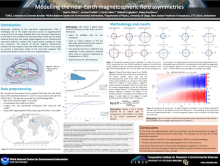Modeling the local time asymmetry of the near-Earth magnetospheric field
Martin
Fillion
CIRES, University of Colorado Boulder
Poster
Data-based modeling of the near-Earth magnetospheric field is challenging due to the highly dynamical nature of magnetospheric currents and to the sparse available data. One important characteristic of this field is the so-called local time asymmetry, which can be clearly observed during the main phase of geomagnetic storms. Modeling this asymmetry requires a dataset with a good spatial coverage at a high time resolution. The network of ground magnetic observatories provides the only magnetic data that meet these criteria. In this study, we present a data-based model of the near-Earth magnetic field produced by electric currents in the inner magnetosphere. Using vector magnetic data from ground observatories, we take advantage of the spatiotemporal coverage of the full dataset to model the local time asymmetries with a one-hour timestep. The magnetospheric field is modeled with spherical harmonics in the Solar Magnetic coordinate frame and its external and induced parts are separated using a time-domain approach. The model is validated by comparing it to satellite data from Swarm, Oersted and CHAMP. The resulting model allows to study the local time asymmetries for all geomagnetic conditions over a period of 24 years. In particular, storm-time asymmetries can be observed for numerous storm events.
The asymmetry during quiet times is subtle and is discussed within the scope of the separation of the ionospheric and magnetospheric fields in magnetic data, which remains a major challenge in geomagnetism. It is believed that this model can provide constraints for the study of geomagnetic storms and substorms.
The asymmetry during quiet times is subtle and is discussed within the scope of the separation of the ionospheric and magnetospheric fields in magnetic data, which remains a major challenge in geomagnetism. It is believed that this model can provide constraints for the study of geomagnetic storms and substorms.

Poster PDF
Poster category
Geospace/Magnetosphere Research and Applications
Meeting homepage